Haunted History of Lord Baltimore Hotel
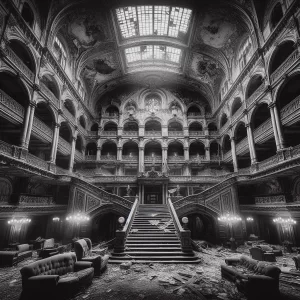
The Lord Baltimore Hotel is one of the 10 top haunted places in Baltimore and has a long, tragic history to back up the name. The hauntings at the hotel also earn it credit as one of the ten most haunted hotels in the entire United States!
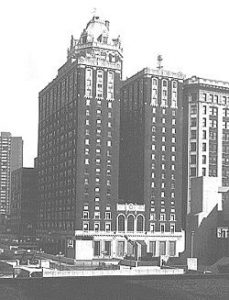
Photo: Wikimedia
During a time of the Great Depression, it is said that the hotel has over 20 documented cases of suicide by jumping from the rooftop after the stock market crash. The souls of the lives lost have stuck around at the place of their tragic and untimely deaths.
History of the Lord Baltimore Hotel
The French Renaissance-style hotel was designed by William Lee Stoddart and opened its doors on December 30th, 1928. At 289 feet in height, the hotel was the tallest building in all of Maryland.
The building is 22 stories high and features a tower with a sky parlor roof of copper that has aged with a green tarnish over the years.
The hotel is noteworthy for voluntarily lifting its racially restrictive guest policies in 1958 when the house failed to pass a bill prohibiting racial segregation in public accommodations.
Renovations of the hotel became necessary in 1982. If you know about paranormal activity, any renovations of a structure that houses death open the portal for hauntings even more!
About the Architect William Stoddart
William Lee Stoddart was a well-known architect from New Jersey credited for designing urban hotels in the eastern United States.
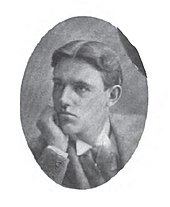
Stoddart prided himself for the efficient, rational designs of his hotels that reflected the enthusiasm for scientific management of that era. Basically, how best to serve your guests that lead to maximum profitability for the hotel. He aimed to capitalize on the market niche of traveling sales representatives.
Personal life drama of William Stoddart
In 1898 Stoddart married Mary Elizabeth Powell in Atlanta, and they settled to raise a family in New Jersey. After ten years of marriage, they separated, causing a great scandal in the New York Newspapers. Marital breakdowns were considered a disgrace in that era.
Mary took her three children, moved to Reno, Nevada, and filed for divorce from William. She alleged “extreme cruelty,” and Stoddart counter-sued with allegations that Mary was inappropriately attracted to Robert L. Shape. Robert Shape was a fellow architect and a friend of Stoddart.
The New York Times published three intimate and personal letters from Mary to William begging him for a divorce and financial help for herself and their three children. Stoddart obliged, and they were divorced sometime between 1908 and 1909.
In 1923 Stoddart remarried in Asheville, North Carolina. His second wife, Sabra Wheless Ballinger, died in 1934.
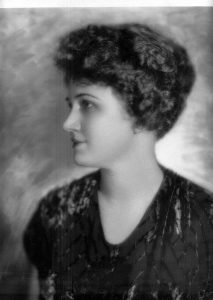
Spending his final years in New York, Stoddart died at age 71 from a stroke. His legacy lives on in his structural genius. One must wonder how many of his historical buildings hold the dearly departed souls that stayed and died there.
Black Tuesday – The Day the Stock Market Crashed
October 24, 1929, is a day those who were alive would have been too young to remember happening, but most know the history behind it. Dubbed “Black Thursday,” the stock market crash on that day resulted from over 16 million shares of stock on the New York Stock exchange being traded by investors in a single day. This panic selling lasted until October 29th, the same year.
Noted as the most devastating stock market crash in the history of the United States, the decline of stocks started on Thursday with the most significant sell-off of shares in U.S. history. This day became known as Black Thursday and was the onset of the devastation our country would go through. Namely, the Great Depression.
Background of the Stock Market Crash
The Roaring Twenties was a time of wealth and excess with post War I optimism for a more prosperous life in the continued growth of the industrial sector.
Investors speculated and believed that the stock market would rise forever. However, in March of 1929, the Federal Reserve warned of trading on excessive speculation. A minor crash occurred when investors began to sell stocks rapidly, exposing the shakiness of the market’s foundation.
National City Bank kicked in 25 million dollars to stop the decline, which temporarily halted the crisis. However, the economic reality was building. Stell production declined, construction was stagnant, auto sales went down, and good old “credit” caused increasing debt for consumers.
Right before the crash, economist Irving Fisher declared the stock market had reached a permanently high plateau. Financial expert Robert Babson predicted that an impact was coming in early September, which could be terrific. However, Irving’s declaration was kicked out of the water, and the financial gains of the great “Bull Market” were soon shaken. The result of this was the start of the Great Crash.
Despite financial gurus buying stock to downplay the sell-off, people panicked. The scenario “what goes up, must come down” took place, and the economy slid right into the Great Depression.
Stock Market Crash Suicide Jumpers
Many of the accounts of suicide jumpers from the Great Crash were grossly exaggerated and fake news created by the media to make a story more interesting. That is, after all, what the media does. However, not to downplay the horrific true accounts, there are accounts of several notables that did take their own lives during the wake of the crash.
All over the country, despondent investors lost their financial means, jobs, and economic security during the years after the impact when the Great Depression took root. The suicide rate all over the U.S. did, in fact, increase during these desperate times.
Some of those jumpers did happen at Lord Baltimore Hotel, where they are all documented. Many believe their spirits stayed at the hotel. They haunt the halls and intermingle with the staff and guests.
The Ghost of Little Molly
The most notorious and saddest account of ghosts that haunt the Lord Baltimore Hotel is the desperate suicidal parents and their 7-year-old daughter Molly.
The couple reportedly stayed at the luxurious Lord Baltimore Hotel the weekend after the crash. Perhaps to soak up some last-minute time together before their desperation took them from the hotel’s rooftop down to the ground where they died.
Some reports say that they didn’t take their daughter with them. However, most reports claim they did – an account of a murder-suicide when it comes down to it. Perhaps the parents felt their daughter was better off dead than living a life of despair which many did in the depression.
Over the years, many guests claim that the little girl is seen around the hotel. Particularly on the 19th floor, which is said to be where the guests had stayed.
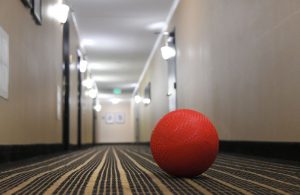
Molly is seen wearing a cream-colored dress and black shoes, and in all accounts, she is accompanied by a red ball. She is seen playing with the ball and is keen on chasing staff members and guests to the point that two hotel employees resigned because of it.
It is also said that the voice and crying of a young girl are heard throughout the hotel. Some believe it could be Molly who is lost and looking for her parents. Staff believes that two formally dressed figures appear to be dancing around the ballroom: the young couple – Molly’s parents.
The Empty Elevator Haunting
Another creepy account of apparent hauntings of the hotel is the elevator that randomly takes a ride to the 19th floor. Many believe the 19th floor is the haunted hot spot for the hotel. Still, when the doors open, there is no one there. Guests riding the elevator have experienced being touched by icy hands. The elevator stops on the 19th floor without being called. Again, when the doors open, there is no one around. Well, at least, there is no one to be seen.
Other hauntings of the Hotel
Documented calls to the reception desk from hotel guests complain about a little girl who is seen and heard bouncing a ball down the hallway. Irritated guests inquire about the whereabouts of the little girl’s parents, and staff has no explanation to offer.
The mysterious occurrences include a handprint of a small child on the wall in one of the penthouses that will never go away. It’s as if Molly is leaving a mark to show she is still there!
Several calls also come in complaining about someone being in their room, usually a woman who appears at the foot of the bed. There’s even a ghost who is a bit of a prankster and hides the remote control to the television. Many guests have also complained that their t.v. turns on and off on its own.
The haunted history began with the first casualty at the hotel and continues to frighten staff members and guests. Management assures that the ghosts are harmless, and if you came to visit, your stay would be luxurious. But don’t count on it being uneventful, and you may not get a whole good night’s sleep!
Read more about the haunted history of Baltimore, and if you dare, take one of our ghost tours in one of the cities across the United States. We guarantee a hauntingly good time!
Sources:
https://www.hauntedrooms.com/maryland/baltimore/haunted-places/haunted-hotels/lord-baltimore-hotel
https://en.wikipedia.org/wiki/Lord_Baltimore_Hotel
https://en.wikipedia.org/wiki/Wall_Street_Crash_of_1929
https://www.hauntedjourneys.com/haunted-inns/3872-lord-baltimore-hotel-1
https://www.wbaltv.com/article/ghosts-walk-halls-of-lord-baltimore-hotel-manager-says/7716969